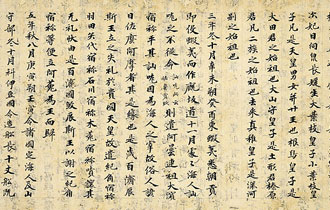Pages |
To adopt the Chinese writing system to write down a language like Japanese that operates on different principles was very much like fitting a square peg in a round hole. To make this mesalliance work, interesting developments took place over several centuries. Initially, Chinese was adopted as the fledgling state's official written language and all documents were written in Chinese. Special problems, however, occurred with native vocabulary, especially people's names and place names. Soon, the Japanese figured out that by affixing a Chinese character to each Japanese mora (recall that a mora is the basic rhythmic unit of Japanese), they could indeed devise a workable writing system that combined Chinese characters with Japanese sounds, but with the result being that the new word often times ignore the Chinese meaning. Kanji (the name for a Chinese character) in this context lost its original Chinese meaning and came to possess only a phonetic value. The first use of this system of writing, now known as man'yōgana, appeared in the inscriptions on swords and mirrors in the sixth century. This type of writing is called man'yōgana because it is the predominant way of writing Japanese found in Man'yōshu, a collection of some 4,500 poems believed to be compiled by the poet Otomo no Yakamochi in the Nara era (710-784). But the choice of which sounds are expressed by which kanji was not at all uniform among the practitioners of man'yōgana. By the end of the Nara era and the beginning of Heian (794-1192), a total in excess of one thousand such kanji were in use to express approximately a hundred distinct Japanese mora 'syllabic unit'.
In sum, Japan has borrowed much from China: the writing system and many actual words, not to mention many aspects of political and social organization. But if we consider Chinese and Japanese languages as systems of communication, we still find that they are very distinct.
Is Japanese Difficult to Learn?
U.S. students find Japanese to be more difficult than commonly-taught European languages such as French, Spanish, or German. In general, it is estimated that it will take an average American learner four times longer to reach a level of competence in Japanese than it does to reach the same level of competence in a European language. There are several reasons for this. Although speaking Japanese is perhaps not any more difficult than learning one of the major European languages, several factors contribute to making Japanese challenging. The first is Japanese typology, that is, the typological characteristics of Japanese--English is SVO and Japanese is XV. This difference begets a number of other linguistic characteristics peculiar to this XV group that speakers of English are not used to, such as the postpositioning of particles to indicate the grammatical relation of the noun to the predicate. But, such difference can relatively easily be overcome.
The second factor is cultural distance. In learning Japanese, as is true for learning any foreign language, learning the culturally appropriate use of language (and even the body language that goes with it) is extremely important. This aspect of language learning is what most distinguishes learning Japanese from learning other languages like French and German. Consider the fact that the cultural distance between, say, the United States and France is much smaller than that between Japan and the United States. This means two things. First, it is often acceptable to exercise American cultural and behavioral norms in France or when learning French without being obtrusive. In contrast, the cultural distance between Japan and the United States is quite large.
Pages |











